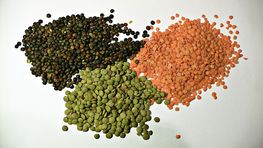
Our word lentil comes, via French lentille, from Latin lenticula, "little lentil;" the ordinary Latin word for lentil is lens (plural lentes.) But lentils weren't given that lens-ey name because they were lens-shaped. It was the other way around: 17th century scientists gave the name lens to the biconvex things that they were experimenting with, because they were shaped like lentils!
When I was younger and more innocent, I was convinced that lentils were a progressive, modern food, invented sometime around the Summer of Love. Totally wrong. Lentils were thoroughly unfashionable in the early twentieth century, but they have been one of the staple foods of Europe from Neolithic times, usually served to the happy peasantry in the form of stew or soup. The ancient Greeks lived on lentil soup and barley bread or barley polenta, plus vegetables, wheat bread and fish, with meat as an occasional luxury. Even more startling: our ancestors were eating lentils long before they domesticated them in the Neolithic. Wild lentils were being gathered and eaten by the Palaeolithic inhabitants of Greece 12,000 years ago.
I have always been attracted to the remarkably healthy lentil, but I had so many disappointing lentil slices, lentil pies and lentil stews served by self-consciously Health Food establishments that I almost gave up. But if you cook lentils the old-fashioned way, they are quite delicious. My favourite recipe is a French peasant recipe for Warm Lentil Salad adapted from Patricia Wells' excellent recipe in her wonderful French cookbook Bistro Cooking; I'm sure that something very like it has been made continuously around the Mediterranean since the Neolithic, and called Lentil Stew. It sounds a lot like what Aristophanes might have gone home to after a hard day of writing bawdy plays.
Always use the best lentils you can find. They're so cheap that even the most expensive, once they're expanded with water, still make a remarkably cheap meal or side dish. The cheapest are large and coarse and tasteless; the best I've tried are the tiny, dark-grey Puy lentils either actually imported from France or grown locally (for those who worry about food miles). Where possible, buy pulses from places with a high turnover. They are definitely not improved by years of storage.
Warm Lentil Salad
2 cups lentils (grey or greeny-brown, NOT split red lentils, or the recipe will turn to sludge)
6 cups water
1 to 4 cloves of garlic (to taste), peeled and crushed
1 onion, peeled and quartered
3 or so bay leaves, fresh or dried (Olympic victors were crowned with wreaths of bay leaves)
Sprigs of herbs: parsley, rosemary, marjoram, and/or thyme, if you have them in the garden
Dressing:
1/4 cup red wine vinegar
2 tablespoons olive oil
one or two teaspoons salt and a good grind of black pepper
1. Place lentils, water, garlic, onion and herbs in a large heavy-based saucepan. Heat gently until simmering. Keep at a gentle simmer, checking that there is enough water and adding more as needed, until lentils are tender. The amount of water will vary according to how old and dry the lentils are.
2. When lentils are tender, drain any excess water. Pour into a serving bowl. Mix dressing in a small jar and shake. Pour dressing over lentils and stir gently. Serve. We often eat this as a main course, but it is a great accompaniment to a roast, or to an assortment of other vegetarian dishes.
It can be tempting to add other healthy things, like celery and carrot, but please resist the temptation. Delicious as they are in their own right, they make the finished dish far too much like health food. Mushrooms can be a good addition; they add a rich texture, and are authentically ancient.
Optionally, you can add a can of tomatoes (unknown in Europe before Columbus), omit the vinegar, heat well, and call it lentil soup. Float basil leaves on top if you have any.
- Jenny
(I copied the photo from the Wikipedia entry of lentils; it's licensed under Creative Commons as
- Description: red, green and puy lentils
- Photographer: User:Justinc)
 RSS Feed
RSS Feed